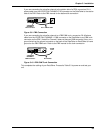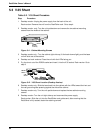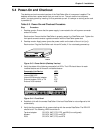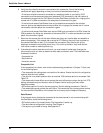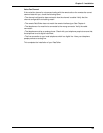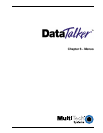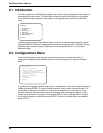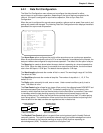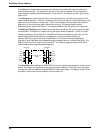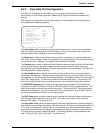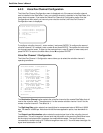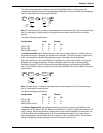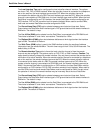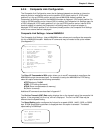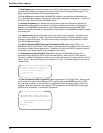
67
Chapter 6 - Menus
6.2.1 Data Port Configuration
The Data Port Configuration menu allows you to configure the data channel for either
asynchronous or synchronous operation, depending on the type of device connected to the
channel. If the port is configured for synchronous operation, refer to Sync Data Port
Configuration.
When the port is configured for asynchronous operation, options such as speed, flow control, and
pacing may need to be changed. The following Data Port Configuration menu displays the default
parameters for async mode of operation:
Data Port Configuration
1 - Async/Sync: Async
2 - Speed: 19200
3 - Word Length: 8
4 - Stop Bits: 1
5 - Parity: None
6 - Flow Control: CTS
7 - Enq/Ack Flow Control: Off
8 - Echo: Off
9 - Pacing: Off
10 - EIA Pass Through: Off
11 - Pass Xon: Off
S - Store All Configurations
M - Main Menu
P - Previous Menu
Selection : _
The Async/Sync option configures the port for either asynchronous or synchronous operation.
When an asynchronous device such as a PC or a host computer is connected to the channel, the
data port needs to be configured for asynchronous operation. The default for this option is Async.
The Speed option needs to be set when the async device is operating at a channel speed other
than 19.2k. When the data channel is connected to an asynchronous device, the channel baud
rate is from 300 bps to 115.2K bps. The default channel speed is 19.2k bps.
The Word Length option sets the number of bits in a word. The word length range is 5 to 8 bits.
The default is 8 bits.
The Stop Bits option sets the number of stop bits. The number of stop bits is 1, 1.5, 2. The
default is 1 bit.
The Parity option sets parity for odd, even or none. Under normal conditions, parity is set to
none. The default is none.
The Flow Control option allows for two types of flow control: the software-based XON/XOFF and
the hardware-based Clear to Send (CTS). The default condition is CTS. Flow control is the
means by which data flow from the channel device into the DataTalker is controlled. Flow control
is necessary when the data handling capacity of the data channel cannot keep up with the
volume of data sent to it. When the channel device controls data flow to itself, it is called pacing
(see Pacing option). The combination of flow control from the channel device and pacing to the
channel device is how data transfers are regulated so that no data is lost.
DATA DATA
Channel
Device
Channel
Device
CHANNEL DEVICE-
INITIATED PACING
DataTalker DataTalker
DATATALKER-INITIATED
FLOW CONTROL
Pacing stops the output of
data from the DataTalker
Flow control stops the input
of data to the DataTalker
The Enq/Ack Flow Control option is a special flow control protocol used in Hewlett Packard
computer systems. This option is sometimes referred to as Enquire/Acknowledge flow control
because it’s based on the computer sending an enquiry (ENQ) and then expecting an
acknowledgment (ACK). The default condition for this option is off.



